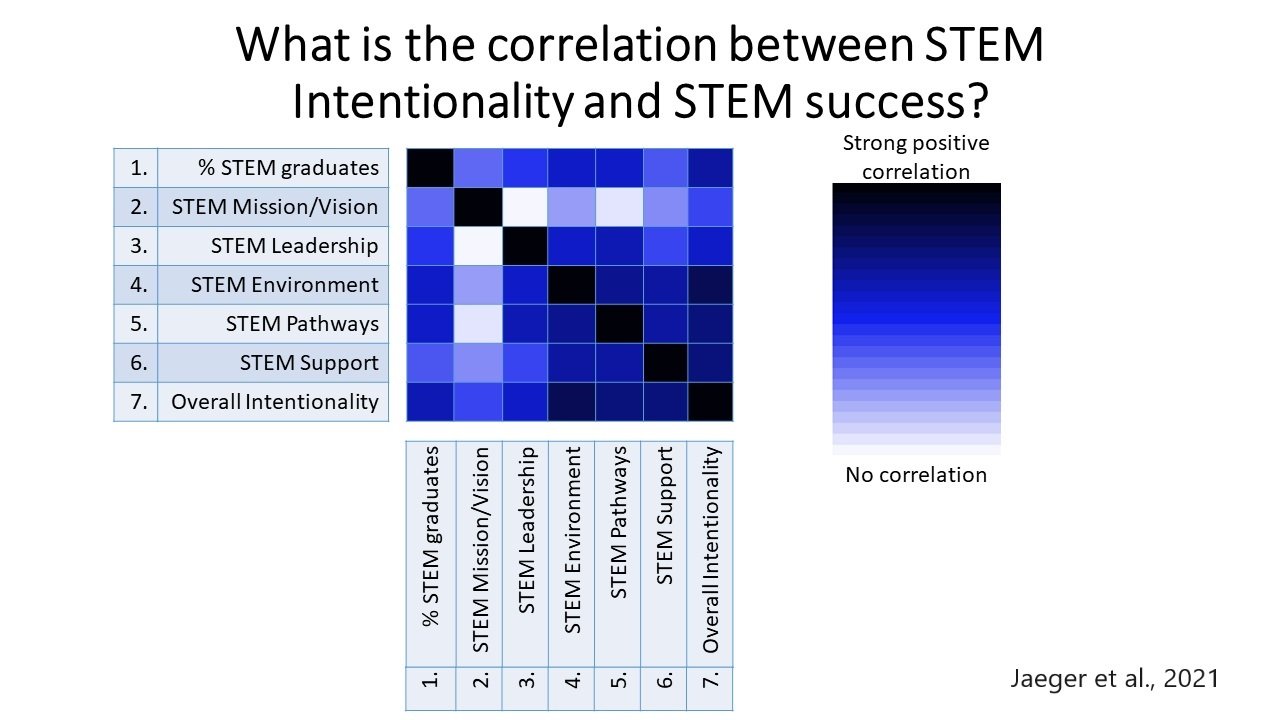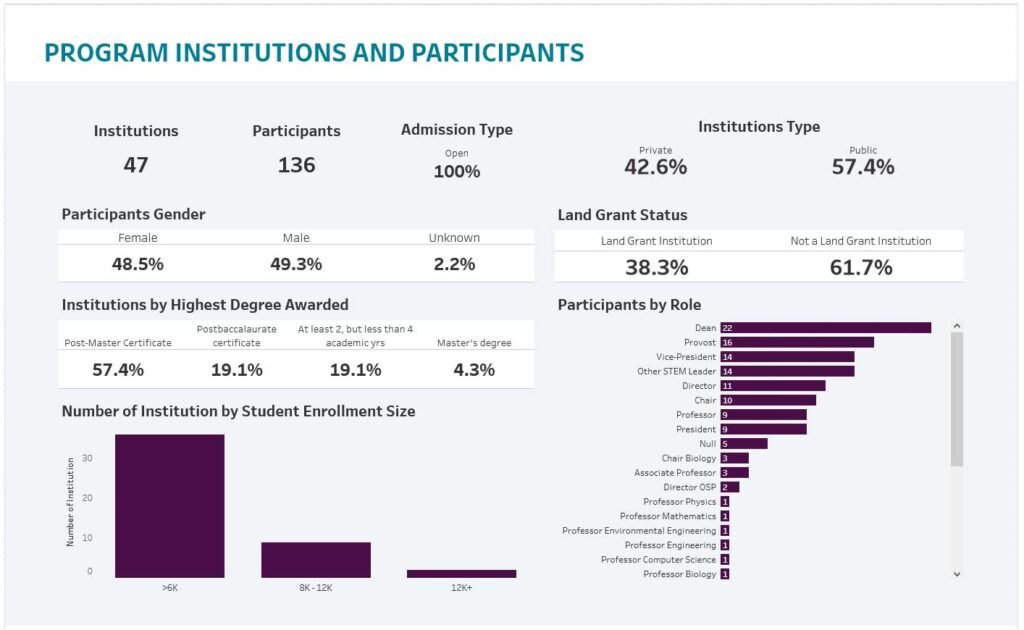
HBCUs are doing something different. It’s working
Recognizing the Role of Leaders in Broadening Participation in STEM
Authors: Ariel Stolz, Angelicque Tucker Blackmon, Teresa Hamilton
Keywords: STEM, HBCUs, Leadership, Broadening Participation, Underrepresented groups in STEM, Nurturing and Supportive Leadership
Citation
Format: Chicago Manual of Style
Stolz, A., Hamilton, T., & Tucker Blackmon, A. (2023, October 3). HBCUs are doing something different. It’s working: Recognizing the role of leaders in broadening participation in STEM. CASL-Research. casl-research.com
RESEARCH
BRIEF


While the United States is at the forefront of advancing science, technology, engineering, and mathematics (STEM), the nation is currently facing a shortage of qualified candidates to fill these occupations. Furthermore, those pursuing STEM careers do not represent the nation’s diversity. Women and minority groups are underrepresented within the STEM workforce. The key to strengthening our nation’s STEM workforce is broadening participation in STEM.
HBCUs excel at broadening participation in STEM
HBCUs excel at broadening participation in STEM. HBCUs are and have been doing something different, and it is working. Cultivating students is one method HBCUs employ, and it contributes to student success in STEM. While the term or action of ‘cultivating’ isn’t novel, the distinct methods of application involved in cultivating students, like positive reinforcement and psychological support, have proven effective and fruitful in the environments HBCUs create. A unique structure that fosters more support for STEM students exists at HBCUs. The difference is noticeable with HBCU’s methods compared to other strategies used in classrooms at other higher education institutions.
Fast Facts
- Although HBCUs make up only 3% of all colleges and universities in the United States, they are responsible for awarding 18% of Black STEM bachelor degrees (Jones & Davenport, 2018).
- HBCUs are the largest producers of Black STEM bachelor’s graduates who continue their STEM graduate degrees (McGee, 2021).
Dr. Aomawa Shields is one of only 26 Black women astrophysicists nationwide. As a pioneer and leader in the STEM enterprise, she knows the importance of cultivating students. She acknowledges how one conversation can change a student’s life trajectory. As a Black woman in STEM, there were aspects of college that Shields didn’t know how to navigate at a predominately white institution of higher education. Her story includes challenges where disparaging criticism from professors and advisors, who suggested she abandon astronomy, deterred her for over a decade before ultimately pursuing her goal. Conversely, support from professors and mentors at HBCUs who approached students’ goals and needs differently revealed that “cultivating” effectively ensures students do not leave or are not left behind.
Historically, HBCUs have been and continue to be places where many students are encouraged and told they can excel and thrive in astrophysics or any other STEM discipline. HBCUs have held a leadership role in broadening participation in STEM for decades. HBCUs contribute to the national need for diverse STEM talent by preparing underrepresented students, primarily African Americans, for STEM professions (Toldson, 2019). HBCUs are pivotal in nationally expanding careers in STEM disciplines (Toldson, 2013). Still, in other places where students go to advance their knowledge in STEM disciplines, too many young, curious minds quickly lose interest in STEM because some people continue to tell them they can’t. Cultivating is obsolete in those spaces.
![]() “HBCUs are able, through cultural connections and caring, to set high expectations. They say, You don’t have to do it alone.”
“HBCUs are able, through cultural connections and caring, to set high expectations. They say, You don’t have to do it alone.”
– President of an HBCU (Engerman et al. 2021)
All Students Begin With A Yearning To Reach For The Stars
Dr. Shields grew up mesmerized by the stars, the sky, and the universe and wished to understand the complexity of observing stars or becoming one as an actor (Han, 2023). The challenges of being told astrophysics couldn’t possibly be the field for her and that she didn’t belong in the place she’d dreamt about since being a young girl were hard to accept. The cosmos would later communicate a path where her two passions, acting and astrophysics, were in orbit. She fostered a different path to space in astrophysics, generating an inspirational story of passion, persistence, and purpose.
As the national statistics show, traditional STEM programs do not cater to broadening participation; therefore, many groups are left behind. At some colleges and universities, from the onset, the goal of introductory STEM courses is to “weed out” as many students as possible by testing students’ ability to persevere through adversity rather than to celebrate and nurture learning and knowledge. Students feel they either sink or swim on their own. This tactic can exacerbate stereotypes, especially in predominantly white institutions, as underrepresented students in STEM are not only dealing with the rigor of the courses but also feeling unsure of their status as important and valuable members of the departments’ STEM community. Those in the majority may feel more sure of their environments and have a sense of belonging, including in social settings outside the classroom, which, although not explicitly acknowledged, add additional psychological and social-emotional support layers. This can give an unseen advantage to students benefiting from additional support while leaving others feeling lacking or inadequate, especially as they navigate the institution and work to identify resources, including study and peer groups.
Dr. Shields entered astrophysics full of dreams and aspirations, then fell victim to internalized feelings of doubt induced by being the only Black woman in her Ph.D. program without verbal or social support. Her mind slowly started to believe the story, that maybe she didn’t belong in the astrophysics Ph.D program. Then, a white male professor reinforced these intrusive thoughts, suggesting she consider other career options. So, she quit and pursued acting instead. Fortunately, Dr. Shields was able to use her passion for acting to regain control of her narrative, find her inner voice and strength despite the external negative voices, and gain the confidence to persist, succeed, graduate from her Ph.D. program, and become a success story as a Black woman in astrophysics and STEM.
The things students carry sometimes create disruption to their working memory, and the lack of belonging may stay with students throughout their academic careers. STEM education is not deliberately aimed at broadening participation, but rather, quite the opposite. Those left behind remain underrepresented in STEM. Imagine if, instead, academic leaders and STEM professors, for instance, told young women and men they could excel and thrive. How different would our world be?
![]() “I was the only Black woman in my Ph.D. program. My mind made a story about that.” – Dr. Aomawa Shields (Han, 2023)
“I was the only Black woman in my Ph.D. program. My mind made a story about that.” – Dr. Aomawa Shields (Han, 2023)
How can we all learn from the success of HBCU leaders to broaden participation in STEM nationwide?
The real power of HBCUs lies in the leaders’ abilities to facilitate success for students that people never imagined being scientists or engineers. This success can be attributed largely to HBCU leadership at all levels, from the President to professors of STEM courses. Those in leadership roles have aided in the success of HBCU students, including those who, in the beginning, were unprepared or not ready for the rigors of higher education (Boncana et al., 2021). HBCUs have brokered pathways toward STEM success for more than 100 years. Yet, a paucity of literature unpacks the leadership behaviors and intentional decisions that Provosts and Vice Presidents make in leading the viability of HBCUs in undergraduate STEM education (Blackmon et al., 2021).
HBCUs have consistently produced top-level STEM graduates, many of whom are otherwise underrepresented in those disciplines. This begs the question: What makes HBCUs and their leaders excel at ushering in STEM success for students who might not otherwise persist in those fields? The Center for the Advancement of STEM Leadership (CASL) research over the past 5 years explores this by identifying leaders’ characteristics and strategies (CASL, 2021). It also explores how these leadership characteristics and strategies can be expanded across higher education, particularly with underrepresented students in STEM majors, and shared with other institutions to broaden participation in STEM nationwide.
CASL significantly expanded the current leadership theories available by including varying types of institutions, private and public HBCUs, and those that are research-intensive or have a liberal arts focus. CASL’s research notably expands the attributes and characteristics of HBCU leaders by enriching the study of leaders to include a range of administrative positions, professorial rank, leadership style, perspective, and identity. The research conducted by CASL included data from 44 public and private 4-year higher education institutions. Nearly 140 interviews were conducted with leaders from various positions, including presidents, provosts, vice presidents, deans, and professors. By including a range of HBCUs and centering the voices of various leaders, CASL research gained novel insights into leadership for broadening participation.
How can we all learn from the success of HBCU leaders to broaden participation in STEM nationwide?
The real power of HBCUs lies in their leaders’ ability to facilitate success for students that people never imagined being scientists or engineers. This success can be largely attributed to HBCU leadership at all levels, from the heads of the institutions to the professors of STEM courses. Those in leadership roles have aided in the success of all their students, including those who, in the beginning, were seemingly unprepared or not ready for higher education’s rigors (Boncana et al., 2021). HBCUs have brokered pathways toward STEM success for more than 100 years. Yet, a paucity of literature unpacks the leadership behaviors and intentional decisions that provosts and vice presidents make in leading HBCUs’ viability in undergraduate STEM education (Blackmon et al., 2021). It is also important to know leadership decisions that facilitated practices that led to student success.
HBCUs have consistently produced top-level STEM graduates, many of whom are otherwise underrepresented in those disciplines. This begs the question: What makes HBCUs and their leaders excel at ushering in STEM success for students who might not otherwise persist in those fields? The Center for the Advancement of STEM Leadership (CASL) research over the past 5 years explores this by identifying leaders’ characteristics and strategies (CASL, 2021). It also explores how these leadership characteristics and strategies can be expanded across higher education, particularly with underrepresented students in STEM majors, and shared with other institutions to broaden participation in STEM nationwide.
CASL significantly expanded the current leadership theories available by striving for diversity, both in the types of institutions, including research universities, liberal arts colleges, and community colleges, and notably by enriching the study of leaders to include a range of administrative positions, professorial rank, leadership style, perspective, and identity. The research conducted by CASL included data from 44 public and private 4-year higher education institutions. Nearly 140 interviews were conducted with leaders from various positions, including presidents, provosts, vice presidents, deans, and professors. By including a range of HBCUs and centering the voices of various leaders, CASL research gained novel insights into leadership for broadening participation.
Leadership can occur at any level
Compelling leadership can occur at any level within the institution; each person who interacts with students and with other faculty can be a leader and influence their peers and students’ self-efficacy, productivity, and, to some degree, success. This can either be a role of inspiration or determent. In the case of Dr. Shields, a faculty member in a leadership role discouraged her from continuing to pursue the field of astrophysics, adversely affecting her ability to graduate from that institution. While all leaders at every level must be empowered and understand their role toward the students in their care, CASL research also indicates that those in the highest positions of senior administration, such as presidents, vice presidents and provosts, can encourage broadening participation in STEM through leadership by facilitating a supportive, nurturing, and caring environment in which collaboration, communication, and engagement are key for both students and faculty (Blackmon et al., 2021; Hendrickson et al., 2021). The HBCU leaders in the previously cited studies encouraged mid-level administration and faculty to feel empowered in their leadership roles by occasionally stepping back and allowing other voices to be heard.
![]() I don’t have to be the person out front and getting all the visibility. I firmly believe that you can lead equally from behind or in the midst.”
I don’t have to be the person out front and getting all the visibility. I firmly believe that you can lead equally from behind or in the midst.”
– Provost at an HBCU (Blackmon et al. 2021)
The importance of diverse role models
Since leadership can happen at any level within the institution, it is imperative that the faculty and administrative staff reflect the vision of diversity within the STEM field that the nation is aspiring for. If any institution wants to succeed, they must look at their STEM faculty and ensure they are as diverse as the class they are trying to graduate. When students and teachers see themselves in the STEM community, it promotes a sense of belonging. When Dr. Shields first began pursuing an advanced astrophysics degree, she lacked a sense of belonging and felt isolated as the only Black woman in her program. The next time she pursued a Ph.D. program a decade later, she instead focused on seeking out mentorship for Black and brown students and found her community. Alternatively, at HBCUs, the instructors and the entire culture are centered around better understanding the context of their student’s academic, mental, and spiritual backgrounds to ensure that the programs focus on helping students succeed and grow. Higher education institutions should look toward the strengths and assets of their students rather than the potential or perceived deficiencies.
HBCUs often hire their own alumni because these future leaders understand the context of being a student at that institution and, therefore, have insights into the student experience and how learning can be enhanced (McGee et al., 2021). Faculty diversity, paired with student-centered programs and alumni engagement incorporating an asset-based perspective, while acknowledging critical race theory and other national challenges in the STEM field, allows students to flourish (McGee et al.; Taylor et al., 2021).
CASL’s research examined how these successful strategies can be taught and developed through programs aimed at helping current and future leaders broaden STEM participation (McClintock et al. 2021). This was done by executing a one-year culturally responsive leadership development fellowship, enabling leaders to enact transformational changes and better address national challenges affecting STEM fields. This program demonstrated that the findings illuminated by this monumental research into the experiences of HBCU leaders can be shared and developed in leaders across institutions of higher education so that the nation can more actively participate in allowing both underrepresented groups in STEM and all students to thrive.
![]() HBCUs are able, through the cultural connection and through caring, to set high expectations. They say, You don’t have to do it alone.”– President of an HBCU (Engerman et al. 2021)
HBCUs are able, through the cultural connection and through caring, to set high expectations. They say, You don’t have to do it alone.”– President of an HBCU (Engerman et al. 2021)

Conclusion
According to a report by the National Science Foundation and the National Center for Science and Engineering Statistics (2019), 25% of Ph.D. recipients in science and engineering from 2013 to 2017 received their undergraduate degrees at HBCUs. HBCUs remain responsible for the vast percentage of African-American STEM and medical professionals nationwide. HBCUs successfully educate Black STEM students because of the institutions’ ability to allow students to “live their best and authentic lives.” (Rankins, 2019). Also, HBCUs are unique because students in STEM fields benefit from engaging with faculty role models (Adams et al., 2017; Toldson, 2019) who respect their views and contributions (Gasman & Nguyen, 2014). According to Toldson et al. (2021), learning from HBCUs and about the practices that have made them successful in educating STEM students is imperative.
The amount of internal energy required to override the external negative voices is exhausting for students. So, connecting with supportive professors and leaders is integral to student success in completing a degree and in the broader one of creating a meaningful college experience a graduate can draw from years to come. The word ‘success’ after the ‘dash’ in the ‘failure-success’ conundrum isn’t afforded to everyone. When Dr. Shields stepped away from astrophysics, most coded her as a failure rather than the context and environment set up for her to fail. Deliberate behaviors communicate that some people with an expressed interest and a passion are deterred from pursuing their dreams. People explicitly verbalize that they should not be in certain spaces or question whether certain people belong in an environment. Why do some academic STEM leaders continue to enable environments that explicitly communicate that some people belong and others do not? Continuing to enable this environment may not necessarily be with malicious intent, but rather, they know the environment is not set up for everyone to thrive. The environment is intentionally structured for the success of some and the elimination of others. The question is, “How, for so many years, has the entirety of STEM education centered on constructing environments that strip down the dreams and aspirations of students entering them? “How far do the roots of the intentional design to push out interested and aspiring students go?” And most importantly, “How can we change this context so everyone succeeds?”
In a recent review of the literature designed to unpack HBCUs’ contributions to STEM education, Ransom (2015) noted that HBCUs support and affirm STEM students and promote cooperative rather than competitive peer climates. Overall, students at HBCUs are also more likely to report a sense of belonging on their campuses and express feelings of being supported by their peers (Toldson, 2013). Within STEM education, research suggests that African-American students attending HBCUs and majoring in STEM disciplines tend to have more positive perceptions of their educational experiences, higher self-efficacy, and more post-baccalaureate educational aspirations than African-American students attending non-HBCUs.
While higher education institutions nationwide struggle to retain and graduate underrepresented groups within STEM fields, HBCUs have been doing the opposite. HBCUs continue to thrive as the largest producers of Black STEM bachelor degree graduates, many of whom continue to complete STEM graduate degrees. The research from the Center for the Advancement of STEM Leadership (CASL) has investigated these successful HBCU leaders and found that by hiring diverse faculty, building student-centered programs, recognizing the impact of critical race theory, and thereby employing an asset-based perspective, and ultimately facilitating a supportive and nurturing environment, students are cultivated and able to succeed and thrive. Furthermore, the invaluable experiences of HBCU leaders can be shared by identifying leadership characteristics and strategies that can be shared with and developed in others to contribute to success in broadening participation in STEM at all institutions across the nation.
This research brief focuses on how HBCU leaders cultivated student success in STEM. Next up is a focus on the Soul of HBCU Leadership. Entitled “The Soul of Leadership: Capturing HBCU Voices in Leadership Frameworks,” Research Brief 2 illuminates aspects of the Soul of Leadership framework developed to account for HBCU leaders’ historical and contemporary behaviors to broaden participation in STEM.



No Comments